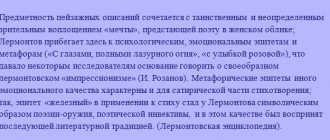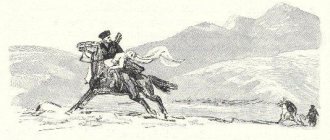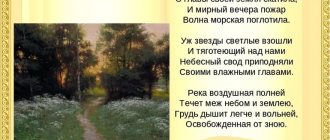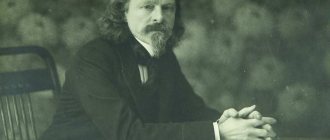History of creation
It is not for nothing that Lermontov’s poems were called prophetic. This was noted by both the people of that time and our contemporaries. A number of poems by Mikhail Yuryevich predict not only his personal fate, but also the fate of the state. His works are imbued with depth and meaning. In each line we can notice the experiences and emotional mood of the author himself.
He wrote the poem “Dream” shortly before his death in 1841. It is in this poem that he predicts his imminent death. Mikhail Yuryevich wrote down the text of the poem in his notebook - a gift before exile, which his close friend gave him. When giving the gift, the comrade expressed the wish that Lermontov would bring it back filled with poems. Unfortunately, the author was unable to bring it back because he was killed in July.
Like several other works, the poem “Dream” was published after the author’s death.
Meaning of the name
Mikhail Yuryevich called the poem “Dream” for a reason. In the title you can see the plot of this work. The dream is visible in the images of the hero himself, as well as in the image of his beloved.
Here the concept of “sleep” has both meanings. The first is in the literal sense of the word, when it comes to the vision of the beloved. The second meaning that the author put into it is the eternal dream of the hero. The author is trying to show that sleep time is a short death, when a person finds himself in a completely different world. It is in this other world that the heroes of the work will meet for the last time. Thanks to sleep, their souls were able to unite. The girl was even mentally able to get to the place where her lover fell asleep forever.
Images and symbols
In describing the landscape, the author uses Dagestan. By showing the rocks, Mikhail Yuryevich emphasizes his alienation and isolation from the outside world. It shows that at the moment of death a person is alone, far from all people and society.
In the prophetic image of the hero we see the author himself, who, with the help of a dream, is trying to tell us about his state of mind and experiences.
The poet also uses antithesis when talking about the sun - a symbol of life that illuminates a dead body. By this he shows that with the death of the hero nothing has changed radically. The sun continues to shine.
In the image of the lyrical hero we can see a strong and brave man who was very lonely. Only after dying does he enter an ideal world where love rules everything.
Means of artistic expression
The rather complex meaning of the work is expressed by the author with a minimal amount of means of artistic expression. However, each trope is filled with deep content.
The poet uses tropes:
- epithet: “sad dream”, “dead dream”;
- personification: “the ledges of rocks were crowded all around”;
- metaphor: “and the soul...is immersed in sleep”;
- metonymy: “with lead in the chest”, “in the midday heat”.
Themes and problems of the work
One of the themes of the work is, of course, the loneliness of the lyrical hero. The fact that he is in distant and rocky Dagestan only better emphasizes the fact that he does not have the slightest desire to be there. He is lonely and sad, and it is this very alienation that leaves the imprint of sadness on the hero.
The second theme can safely be called the theme of death. This is precisely the main problem of the work, in which it is closely intertwined with love. It's like an eternal neighborhood of good and evil, which cannot exist alone. This is the main idea of the poem “Dream”.
Also, the author, through the description of the landscape and nature, conveys the whole mood of the work. The description of lonely rocks shows the mood of the lyrical hero, emphasizing his loneliness. The sun, which continues to shine high in the sky, acts as a counterweight to death itself. The entire poem is permeated with tragedy and loneliness. The author conveys that a person is always alone in the most important moments of his life. He comes into this world and leaves it completely alone. Even love comes only in a dream.
Composition
The composition of the poem “Dream” is conventionally divided into two parts.
- In the first two stanzas, the picture of the death of the lyrical hero is revealed to the reader. He lies on a “ledge of rock” with a fresh wound from a shot, which continues to “smoke” and “blood flows” onto the dusty ground of Dagestan. Smoke from the wound indicates the hero's recent death. At the end of this part he falls into a “dead” sleep.
- The second part is framed by three stanzas. It begins joyfully with pictures describing his homeland, where news of the hero’s death has not yet reached. This is the compositional center of the poem. Here the image of the lyrical heroine, his beloved, appears. She seems to feel something is wrong, feels sadness that is firmly lodged in her chest. The reader is presented with a “dream within a dream” narrative form. Now the heroine dreams of what happened to her lover. She sees a “familiar” body on the bloody ground in the “valley of Dagestan.” At this moment, lovers acquire a strong spiritual connection.
The peculiarity of the composition in the poem “Dream” is that it is circular: the last stanza again returns us to the first.
The main idea of the work
The main idea of the work is the love of two heroes, which even the death of the hero could not prevent. The death of the hero occurs completely alone, and no one knows about his death. But you cannot deceive a loving heart, so the heroine, being at a great distance from him, felt that trouble had happened to her beloved. She is convinced of her premonition during a dream, where she sees everything that happened to the lyrical hero in distant Dagestan.
The main idea can also be said that even death could not break that invisible connection that forever linked two loving hearts. They meet for the last time, albeit in a dream. Their souls are intertwined into a single whole, which even death is not afraid of.
The idea that the author put into the work gives us the opportunity to think about death and its inevitable arrival. After all, sooner or later absolutely every person is destined to meet her. This allows you to try to find the meaning of your life. Reconsider your views and actions so as not to find yourself on the last day of your life as lonely as the lyrical hero of the work. And while there is still time, there is an opportunity to try to change your life for the better and become happy.
Lermontov encyclopedia “DREAM” (“IN THE AFTERNOON HEAT IN THE VALLEY OF DAGESTAN...”)
To the beginning of the dictionaryBy first letter
0-9 AZ A B C D E F G H I K L M N O P R S T U V
“DREAM” (“IN THE AFTERNOON HEAT IN THE VALLEY OF DAGESTAN...”)
"DREAM"
(“In the midday heat in the valley of Dagestan...”) (1841), verse. from novelistic a plot often found in L.’s later poems (“Testament”, “Neighbor”, “Neighbour”, “Prisoner”). “The Dream” was written on behalf of a person who is on the verge of life and death, and this already largely predetermines a special ontological mystery. the mystique of Lermont. verse., this phenomenon Russian. poetry. The hero of the ballad has a dream about his own. death and in his dream - the dream of the woman he loved, who prophetically foresaw his death. And this dream is devoid of any surreal dream conventions, it is extremely clear and specific - despite the fact that its content is like poetry. overall, deeply symbolic.
Ill. S. V. Ivanova. Black watercolor. 1891.
The pervasive connection between the motives of love and death finds expression in a complex plot form, built on the principle of “generation” - one plot-psychology. a situation (the dream of a lyrical hero) gives rise to another (the dream of the woman he loves), or “investments” - the dream of one is “invested” into the dream of another; Wed not identical, but similar in “Stanzas” (“I can’t languish in my homeland”): “So, but if I don’t forget / In this [mortal. - Ed.] a dream of love, a sad dream...” B. Eikhenbaum, exploring genre and composition. originality of “The Dream”, called its construction “mirror”: “The hero’s dream and the heroine’s dream are like two mirrors, mutually reflecting the actual destinies of each of them and returning their reflections to each other” [Eikhenbaum (7), p. 252); as defined by V.S. Solovyov, this is a “dream in a cube.”
Symbolic and composition complexity verse. contrasts with the emphasized simplicity of the poetic. stylistics, lack of metaphor. imagery: all used in verse. epithets - general poetic or neutral. But the instrumentation of the verse, internal. rhymes, assonances and alliterations (“In the day
the
evny
heat
in
the
valley of
Dagestana
...
lay
motionless
...
And
the
sun burned
their yellow
peaks
and
scorched me
... "
) in
combination
with _ _ _
_
_ anaphors and junctions creates a complex music. drawing. Intonation and music the movement of the verse is correlated with its ring structure, which is not uncommon in lyric poetry. genres; here it receives a fundamentally new content, determined by the special logic of plot development. The first and last ring quatrains belong not to one, as usual, but to different consciousnesses: the hero (“I lay motionless”) and the heroine (“and she dreamed…”). Such a circular repetition - one person “recognizes”, recreates down to the details the death of another - conveys a special, “resolving” meaning of the tragic. verse to the plot, contained not only in death, but in the very “observation” by the hero of the ballad of his dying: “The deep wound was still smoking, / Drop by drop my blood was drained.” “Dream” does not give rise to that “chilling despair” that V. G. Belinsky spoke about in connection with L.’s later poems. If the hero of L.’s early lyrics constantly turns to the woman he loves with a prayer, a spell to preserve the posthumous memory of him - “with a demand not so much for love as for memory” - then in art. In the space of the ballad, the image of ideal love that lived in L., which turned out to be prophetic, seems to come true and is fully understood. And this kind of love, which I experienced only in the sleep of death, but managed to do so - through the power of my own. epiphany - to see the hero verse., brings the theme of death out of absolute, closed tragedy.
Various assumptions have been made regarding the origin of the “Dream,” but some versions cannot be accepted due to chronological reasons. inconsistencies. Some researchers associate it with the name of V.A. Lopukhina, others - with E.P. Rostopchina; the latter, according to Eikhenbaum, is more likely. E.A. Sushkova unreasonably believed that the reason for creating “Dream” was the news of her alleged marriage with A. A. Lopukhin: L. supposedly warned Sushkova that he would challenge her fiancé to a duel...On this occasion, he wrote the poem “Dream” (Sushkova, p. 226). G. Gradovsky names another source - the memories of a gene. M.H. Schultz, who told L. how after the battle he lay wounded all day among the dead until he was picked up. L. Semenov suggested in verse. the influence of the folklore of the Greben Cossacks, S. Shuvalov - the lyrics of G. Heine. However, there is no doubt that it is in verse. The gloomy forebodings that possessed L. after his last departure from St. Petersburg were also reflected. The motive of the dream is about one’s own. death was developed by L. in his early lyric poetry, marked by an intense search for a solution to the eternal mystery of existence (cf. “Night. I”, “Death” - “Caressed by blooming dreams ...”). As A. Bezhetsky pointed out, the plot of “The Dream” was developed into verse. unknown author, which was attributed to L. The influence of “Dream” can be seen in the verse. N. P. Ogareva “In the silence of the night there is a sad chord...”. Lermont motives. poem. are repeated in the lyrics of A. Isahakyan (“Yes, I always know - there is a foreign country”).
Belinsky considered “Dream” to be one of the “most significant” works. L., equally interesting “both aesthetically and psychologically” and belonging “to the era of full development” of his talent. N. G. Chernyshevsky cites this verse. as an example of true beauty in poetry. Later interest in poetry. form of “Dream”, its aesthetic. content, to be reflected in verse. L.’s personality was especially characteristic of researchers close to symbolists: V.V. Rozanov, D.S. Merezhkovsky found in “The Dream” a prophetic dream of L. himself, a mystic. the poet's insight. Issues of composition and instrumentation of “Dream” are covered in the works of S. Shuvalov and I. Rozanov; the latter also analyzes L.'s work on the autograph.
Poem. illustrated by G. G. Gagarin, S. V. Ivanov, D. N. Kardovsky, K. A. Korovin, P. Litvinenko, D. I. Mitrokhin. Set to music by more than 20 composers, incl. M. A. Balakirev, Ya. F. Prigozhy, S. N. Vasilenko, A. N. Drozdov, V. M. Ivanov-Korsunsky. From ser. 19th century “Dream” has firmly entered the folk song repertoire. In 1915, on the stage of the Mariinsky Theater M. M. Fokin staged the ballet “The Dream” (music by M. I. Glinka, script by Fokine).
Autographs: Belova - GPB, Collection. handwritten L., No. 12 (notebook donated by V.F. Odoevsky), fol. 7 vol., draft - in the same place, l. 21-22. For the first time - “OZ”, 1843, No. 4, dept. 1, p. 183. Dated to the summer of 1841 according to the position in the notebook.
Lit.: Belinsky, vol. 7, p. 38; vol. 8, p. 94, 339; Chernyshevsky, t. 2, p. 134; Bezhetsky A., “Dream”, “New Time”, 1891, July 15; Rozanov V., Lermont. house in Pyatigorsk, “New Time”, 1908, June 23; Lerner N., About “Dream” L., ibid., June 24; Merezhkovsky D.S., M.Yu.L. Poet of superhumanity, St. Petersburg, 1909, p. 35-36; Rozanov I. (1), p. 242; Rozanov I. (3), p. 115-22, 169-70; Semenov (5), p. 136-37; Shuvalov (4), p. 269; Vinogradov G., LN, t. 43-44, p. 361-63; Eikhenbaum (12), p. 350-51; Popov (2), p. 150-53; Gerstein (8), p. 344-45; Maksimov (2), p. 101; Norets Zh. S., M. Yu. L. in Nar. songs and vocal creativity of Russian. composers, in collection: VI conf. (Stavrop.), p. 196; Memoirs (2), p. 285-86; Zaslavsky I. Ya., On poetic mastery (from observations of the poet’s last poems). Debrecen, 1965, p. 28-31; Udodov (2), p. 169-71; Chicherin (1), p. 413; Gay N.K., The artistry of literature. Poetics. Style, M., 1975, p. 191-93.
To the beginning of the dictionary









